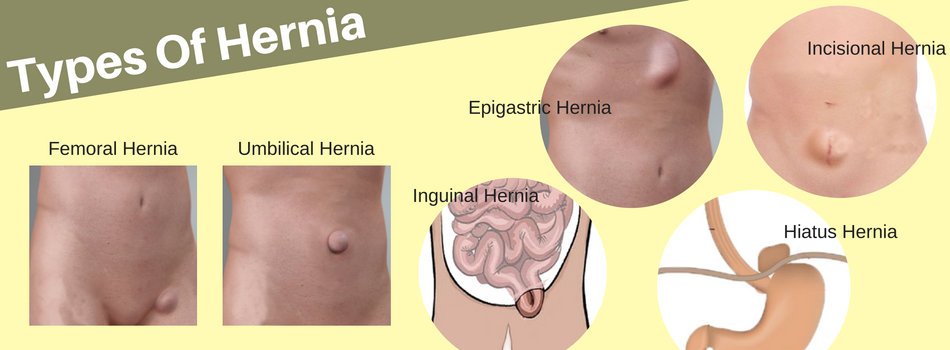Are there different types of Hernia?
Yes, there are different types of Hernia. A hernia can occur in the abdominal walls, brain, spine, and chest cavity. However, the Hernia occurring in the abdominal walls is the most common and we can presume that it can be over 95%. The Hernia occurring in the abdominal wall can be classified based on where in the abdominal region the Hernia has occurred. There are many types of a hernia, which the common 6 types are Inguinal, Femoral, Umbilical, Epigastric, Hiatal and Incisional Hernias.
Different types of Hernia:
An Inguinal Hernia – This is the most common type of Hernia of all. It occurs exclusively in men. Just before birth, a male child’s testicles normally descend from the abdomen through the inguinal canal into the scrotum. Within 3-6 months, this inguinal canal closes naturally. However, for known and unknown reasons, this remains open or opens later in life causing Hernia.
A Femoral Hernia – Among the many types of Hernia, a femoral hernia is common among women. However, it can occur in men too very rarely. The weak spot in this type of Hernia is in the lower groin area. This weakness can induce the intestine sac to protrude into the femoral canal. Since complications are common and early in this type of Hernia, the surgeon may strongly advise for early surgical cure.
An Umbilical Hernia – As the name goes this Hernia occurs near the bellybutton area. The naval or the umbilicus is the weakest spot in the abdominal wall. So naturally, it occurs in infants because of the umbilical cord. In adult women, a normal pregnancy can lead to umbilical Hernia. Generally, any obese individuals, male or female, are prone to Umbilical Hernia.
An Epigastric Hernia – This Hernia occurs as a result of a weak spot below the chest bone in the midline. This type of Hernia is more common in men than women and the factor that typically causes this Hernia is obesity or pregnancy.
A Hiatal Hernia – This Hernia is not caused as a result of the weakness of any wall but a weakness in the diaphragm, a muscle layer that separates the chest cavity and abdominal cavity, through which the food pipe goes from chest to abdomen. Through this Hernia, the upper part of the stomach called fundus slides into the chest cavity bringing food and acid. This presents as an acid reflex. This acid reflex from Stomach to Esophagus can result in immense pain in the chest and not in the abdomen mimicking cardiac problems.
An Incisional Hernia – When Hernia appears in a site where surgery was done prior, it is termed as Incisional Hernia. This Hernia can happen in weeks or months or years after surgery and so does not have any timeline for the occurrence. This is the most common abdominal wall Hernia in women generally after hysterectomy or cesarean. Because of previous surgery, the intestine anatomy is altered and hence more complications might occur if left untreated. Hence your surgeon may advise for immediate surgery to avoid complications.

